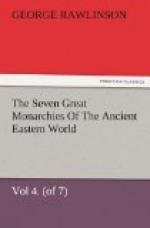The chief objects of Babylonian worship were Bel, Merodach, and Nebo. Nebo, the special deity of Borsippa, seems to have been regarded as a sort of powerful patron-saint under whose protection it was important to place individuals. During the period of the later kingdom, no divine element is so common in names. Of the seven kings who form the entire list, three certainly, four probably, had appellations composed with it. The usage extended from the royal house to the courtiers; and such names as Nebu-zar-adan, Samgar-Nebo, and Nebushazban, show the respect which the upper class of citizens paid to this god. It may even be suspected that when Nebuchadnezzar’s Master of the Eunuchs had to give Babylonian names to the young Jewish princes whom he was educating, he designed to secure for one of them this powerful patron, and consequently called him Abed-Nebo—the servant of Nebo—a name which the later Jews, either disdaining or not understanding, have corrupted into the Abed-nogo of the existing text.
Another god held in peculiar honor by the Babylonians was Nergal. Worshipped at Cutha as the tutelary divinity of the town, he was also held in repute by the people generally. No name is more common on the cylinder seals. It is sometimes, though not often, an element in the names of men, as in “Nergal-shar-ezer, the Eab-mag,” and (if he be a different person) in Neriglissar, the king.
Altogether, there was a strong local element in the religion of the Babylonians. Bel and Merodach were in a peculiar way the gods of Babylon, Nebo of Borsippa, Nergal of Cutha, the Moon of Ur or Hur, Beltis of Niffer, Hea or Hoa of Hit, Ana of Erech, the Sun of Sippara. Without being exclusively honored at a single site, the deities in question held the foremost place each in his own town. There especially was worship offered to them; there was the most magnificent of their shrines. Out of his own city a god was not greatly respected, unless by those who regarded him as their special personal protector.
The Babylonians worshipped their gods indirectly, through images. Each shrine had at least one idol, which was held in the most pious reverence, and was in the minds of the vulgar identified with the god. It seems to have been believed by some that the actual idol ate and drank the offerings. Others distinguished between the idol and the god, regarding the latter as only occasionally visiting the shrine where he was worshipped. Even these last, however, held gross anthropomorphic views, since they considered the god to descend from heaven in order to hold commerce with the chief priestess. Such notions were encouraged by the priests, who furnished the inner shrine in the temple of Bel with a magnificent couch and a golden table, and made the principal priestess pass the night in the shrine on certain occasions.
The images of the gods were of various materials. Some were of wood, others of stone, others again of metal; and these last were either solid or plated. The metals employed were gold, silver, brass, or rather bronze, and iron. Occasionally the metal was laid over a clay model. Sometimes images of one metal were overlaid with plates of another, as was the case with one of the great images of Bel, which was originally of silver but was coated with gold by Nebuchadnezzar.




